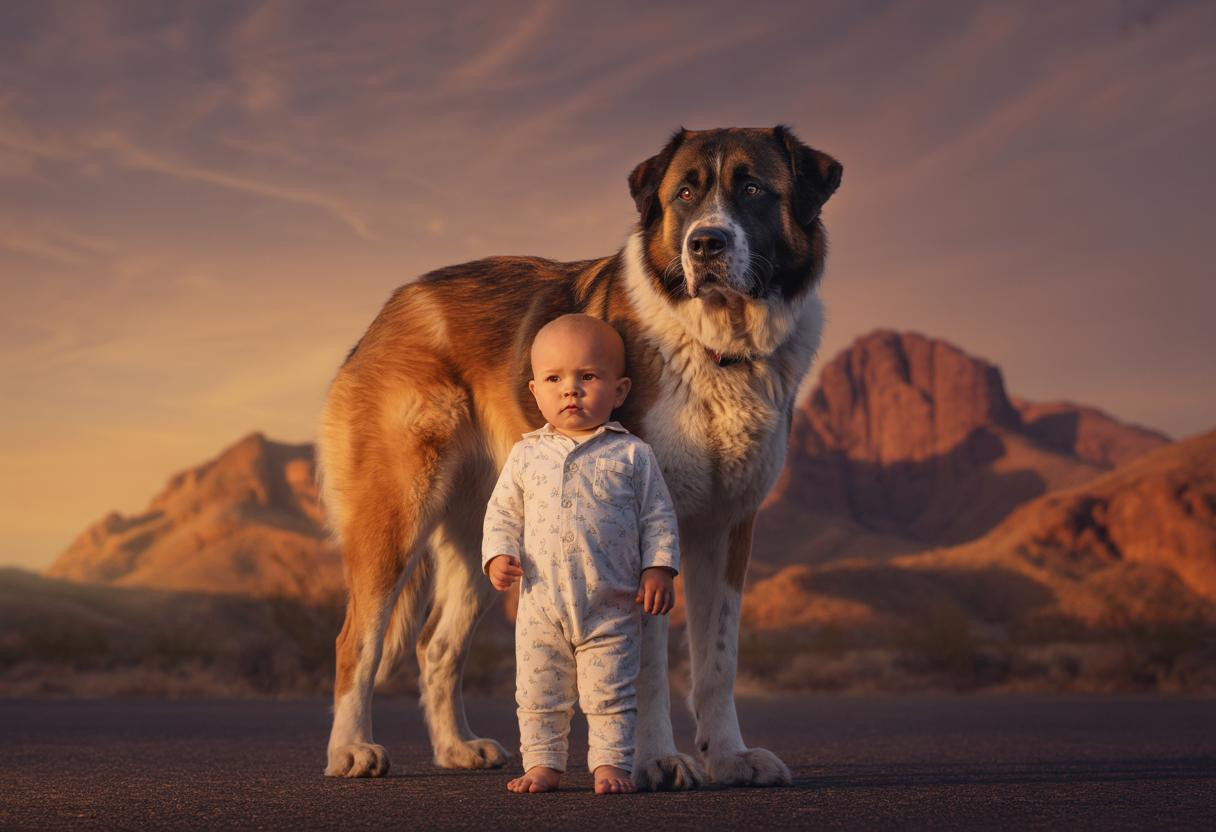When 2-year-old Boden Allen vanished into Arizona’s unforgiving desert terrain, rescue teams mobilized 40 searchers and helicopters for what typically becomes a tragic ending. But 16 hours later, something unprecedented happened – a 160-pound ranch dog named Buford had not only found the toddler alive but guided him over a mile to safety, rewriting everything experts thought they knew about wilderness survival and cross-species rescue.
The case unfolded in April 2025 near Seligman, Arizona, where temperatures plummeted to 40°F and mountain lions prowled the rugged terrain. Boden had wandered 7 miles from home wearing only a tank top and pajama pants, facing odds that seasoned search professionals describe as nearly impossible.
The remarkable survival mechanics that saved a toddler’s life
Unlike adults who often experience cognitive paralysis during crises, Boden’s young age became his unexpected advantage. Research on stress management approaches shows that children under 3 lack the fear-processing mechanisms that can paralyze adults in dangerous situations.
His survival hinged on three critical factors: finding shelter under a tree that protected him from wind exposure, maintaining core body temperature despite minimal clothing, and crucially, the protective presence of Buford throughout the frigid night.
The desert’s cold actually reduced immediate dehydration risks, though experts note that survival probability in such conditions typically remains below 15% for children this age, even with ideal circumstances.
Environmental challenges that should have been fatal
The high desert terrain presented a deadly combination of obstacles: jagged mountain ranges, hidden valleys, and active predator populations. Search teams spotted two mountain lions in the immediate area during rescue operations, highlighting the very real threat Boden faced.
His small body surface area, typically a disadvantage for heat retention, may have actually helped conserve energy during his 7-mile journey across terrain that challenges experienced hikers.
How Buford’s guardian instincts created an unlikely rescue
Buford, an Anatolian Shepherd-Great Pyrenees mix, represents breeds specifically developed for livestock protection. His response wasn’t trained behavior – it was pure evolutionary instinct kicking in when he encountered a vulnerable human child.
These guardian breeds possess remarkable situational assessment abilities, recognizing distress signals across species lines. Buford’s actions – staying with Boden overnight, then escorting him to the ranch – mirror exactly how these dogs protect their herds from predators.
The science behind cross-species protection
Unlike traditional search-and-rescue dogs that follow scent trails, Buford demonstrated emergent altruism – spontaneous protective behavior without human commands. This suggests that certain dog breeds maintain hardwired empathy circuits that extend beyond their immediate pack.
His overnight protection likely prevented hypothermia and deterred the mountain lions that search teams confirmed were in the area, essentially creating a mobile safety zone around the lost child.
Revolutionary implications for wilderness rescue operations
The rescue operation’s most striking element wasn’t the 40-person search team or helicopter surveillance – it was how traditional methods failed while a ranch dog succeeded. This outcome challenges fundamental assumptions about organized rescue protocols.
Modern wilderness survival technology, including advanced survival devices, couldn’t locate Boden, yet Buford’s instincts immediately identified and solved the crisis.
Future search operations could integrate livestock guardian dogs from local ranches, especially in remote areas where these animals know the terrain intimately. Their natural protective instincts could supplement traditional SAR methods rather than replace them.
Technology meets ancient instincts
Thermal imaging drones and GPS tracking represent the cutting edge of search technology, but Buford’s success suggests that biological intelligence still surpasses artificial systems in complex, unpredictable environments.
The integration of local animal assets into formal rescue protocols could revolutionize how we approach wilderness emergencies, particularly in vast, difficult terrain where conventional methods struggle.
Understanding the deeper psychological and social implications
Boden’s case reveals fascinating insights about childhood resilience and trauma processing. Research on environmental factors affecting toddler development suggests that while Boden may not fully comprehend his ordeal, the experience could influence his relationship with nature and animals for life.
The family’s trauma, however, was acute and immediate – 16 hours of not knowing whether their child was alive represents psychological stress that requires professional support and community understanding.
What this extraordinary rescue teaches us about survival
Boden’s survival challenges our assumptions about vulnerability, intelligence, and the power of interspecies cooperation. Sometimes the most sophisticated rescue technology can’t match the ancient wisdom of a dog’s protective instincts. This case reminds us that in our increasingly digital world, the most profound solutions often come from the natural intelligence that surrounds us – if we’re wise enough to recognize and respect it.
